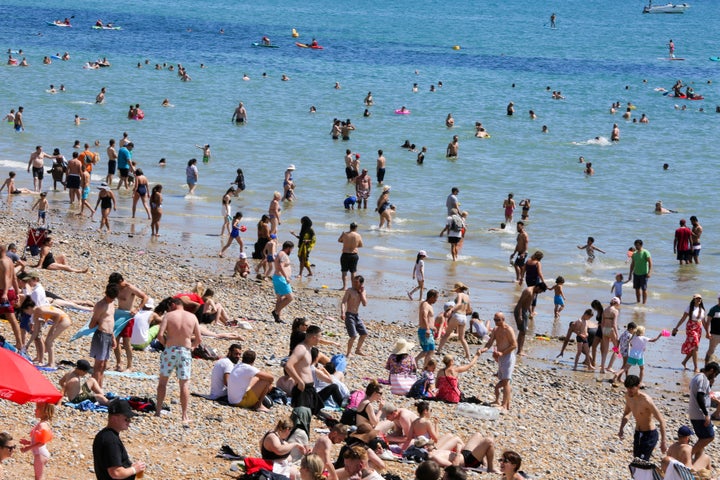
As temperatures are set to reach staggering heights for the UK on Sunday, Monday and Tuesday, a “national emergency” has been declared.
It comes after the government’s emergencies committee, COBRA, met on Thursday to discuss the dangerous weather, and after the Met Office increased its own alert level.
The same heatwave is across Europe right now too, with wildfires catching in Portugal, France and Spain, causing further alarm.
But just what does this mean, and why is it happening?
What is a national emergency?
The UK Health Security Agency (UKHSA) says a “level four” national emergency is declared if the hot weather becomes so extreme that “illness and death may occur among the fit and healthy”.
A UKHSA spokesman told The Mirror on Thursday: “There’s a possibility of a level four heatwave. If it gets above 40C, then it is likely to be a level four heatwave for the first time.
“I don’t see how it couldn’t be in those temperatures.”
Any decision to declare a major incident is made by the Cabinet Office, after consulting with government departures and nominating staff to manage the response.
Notably, it is the only level of alert which is defined by the threat to society as a whole, rather than a temperature threshold – meaning many factors have to be taken into account.
But, ultimately, a national emergency would be declared if “the integrity of the health and social care systems is threatened”.
A national heatwave emergency has never been declared before.
After COBRA meeting yesterday, Cabinet Office minister Kit Malthouse confirmed the priority was to “prepare” government services.
The prime minister’s spokesman also said earlier this week there were “tried and tested” plans in place to increase NHS staffing in various areas, and there has already been some government co-ordination to put mitigations and actions in place.
He emphasised that this is mainly about “making sure the public are aware of the advice that is available”.
What does a national emergency look like for UK services?
It means services across the UK are likely to deviate from their normal routines.
Schools would probably close if conditions are too hot and hosepipe restrictions could be introduced as water companies may introduce water-saving measures on water pressure or limiting 24/7 supply.
Transport may be impacted – road surfaces may melt due to the sun and rail tracks could warp, although Network Rail has already put speed restrictions in place to reduce the warping of tracks, and is monitoring temperatures.
The London Underground Network would deploy hot weather noticed and bottle water supply if temperatures remain above 24C for three days in a row.
Vulnerable groups have already been urged to take care, although the health care system may have to adapt to dealing with an influx with patients.
Health providers have already released alerts on how to keep cool, with some health commissioners assessing public events and trying to reduce necessary travel.
Visits or phone calls would be put in place to check up on high-risk people, and care homes and hospitals would start monitoring indoor temperatures.
It’s not entirely clear how the government would deal with other potential issues, such as power outages, caused by more people turning to power air conditioning and fans. High temperatures may even affect the cooling systems in power stations and decrease their efficiency.
The environment could be impacted too, with accelerated growth of blue-green algae – affecting fish and swimmers, and higher concentrations of ozone levels. WIldfires are more of a risk – as seen across Europe – and even crops may be damaged by the heat.
It’s also unclear what would happen to local services, like bin collections.
Met Office’s red extreme heat warning
In another first for the UK, the Met Office has just released a red warning for extreme heat across parts of England, in line with the UKHSA. This is its highest alert level and means there is a risk to life.
It is across East Midlands, East of England, London and South East England, North West England, South West England, West Midlands and Yorkshire and Humber for both Monday and Tuesday.
The weather forecasters predict that temperatures will reach 35C although other computer models claim it will be higher at 40C by Tuesday.
This is a temperature which has never been reached before in Britain.
According to the Met Office, hot weather stems from high pressure over the UK and the hot air entering from southern Europe.
The highest level of warning means there could be serious impacts on people and infrastructure – and it’s not limited to those vulnerable to extreme heat.
It could lead to serious illness or be a danger to life.
Substantial changes in working practices and daily routines will be expected, to help people get through the heat.
The Met Office also predicts there will be an increase in the number of people visiting coastal areas, lakes and rivers means there are likely to be more water safety incidents.
Could records be broken?
The highest recorded temperature in the UK was 38.7C in Cambridge in 2019.
According to the BBC Weather presenter Matt Taylor, there is an “increasing likelihood” the UK record high would be broken in the coming days.
Referring to the staggering weather coming up, he said: “That is exceptionally hot, it is the sort of temperatures that if you are on holiday you may be able to deal with but in day-to-day life it can have severe impacts on health and we are likely to see impacts on transport and power next week as well.”
At night, the temperature may still not drop below 25C although it will start to cool down from Wednesday.
Anything over 20C at night is classed as a “tropical night”.
